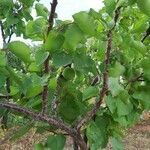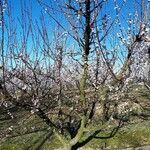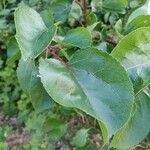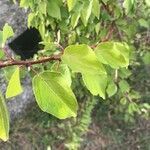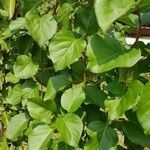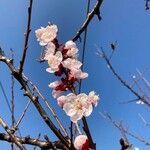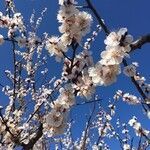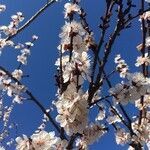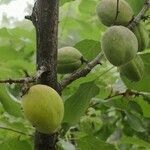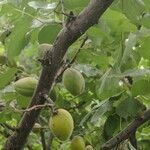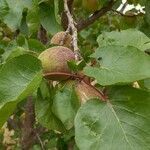Trees, not suckering, 50–100 dm, not thorny. Twigs with axillary end buds, glabrous. Leaves deciduous; petiole (12–)20–45 mm, glabrous, glandular distally or on margins at bases of blades, glands 1–5; blade broadly ovate to suborbiculate, (3–)5–9 × (2–)4–8 cm, base usually obtuse to rounded, sometimes truncate or subcordate, margins singly to doubly crenate-serrate, teeth blunt, glandular, apex abruptly short-acuminate, abaxial surface with tufts of hairs in vein axils, adaxial glabrous. Inflorescences solitary flowers. Pedicels 1–3 mm, hairy. Flowers blooming before leaf emergence; hypanthium tubular-campanulate, 4–6 mm, glabrous or sparsely hairy externally; sepals reflexed, oblong-ovate, 4–6 mm, margins remotely glandular-toothed, surfaces sparsely hairy; petals white (pink in bud), broadly elliptic to suborbiculate, 8–12 mm; ovaries hairy. Drupes yellow to orange, often tinged with red, ellipsoid to globose, ?laterally compressed?, 25–60 mm, velutinous; mesocarps fleshy; stones ellipsoid to subglobose, strongly flattened, ?not pitted?. 2n = 16.
More
A medium sized deciduous tree. It grows 10 m tall. It is a broad spreading shape. The bark is dark red-brown and smooth and shiny. The leaves have stalks. The leaves are broadly oval. They are 10 cm long by 6 cm wide. They are rounded at the base and taper to the tip. They have shallow round teeth along the edge. The leaves are glossy and dark green. The flowers are 2.5 cm across and pale pink or white. They are almost without stalks and have 5 petals. They occur singly on old shoots. The fruit is fleshy and rounded. It is yellow and can be flushed with red. There is a hard covering over the seed. This stone is smooth. The seeds are oval. The flesh is edible. The seeds are edible.
Spreading tree to 10 m; lvs broadly ovate to subrotund, abruptly acuminate, 5–10 cm, nearly as wide; fls solitary, sessile or nearly so, white or pale pinkish, 2–3 cm wide, appearing in early spring; fr subglobose, very thinly velvety, 3–5 cm thick; stone compressed, smooth; 2n=16. Native of w. Asia, long in cult. and rarely adventive in our range
It is a temperate plant. It is native to C. Asia and N. China. It grows in cool areas with hot dry summers. They do best on a free draining soil. In Nepal plants grow between 2500-3500 m altitude. It does well in areas with 100 cm rainfall, cool winters with 300-900 chilling hours below 7°C and frost free spring. A pH of 6-6.8 is suitable. It needs good sunlight. It suits hardiness zones 5-10.
More
Most trees growing apparently wild have escaped from cultivation but there are pure stands of the trees in western China, growing on mountain slopes in sparse forests at elevations from 700-3,000 metres.
The ripe fruit are eaten. The kernels can be eaten. If sweet they are eaten fresh and if bitter they are roasted. They should be used with caution. The seed oil is used for cooking. The fruit are also used for juice and are dried and eaten dry. They are also used for jam, and in pastries, pies, cakes, and picked.

